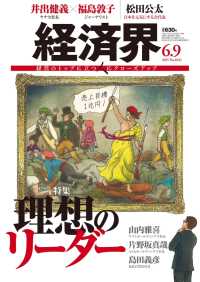- ホーム
- > 洋書
- > 英文書
- > Religion / Ethics
Full Description
Much has been written on witchcraft by historians, theologians, philosophers, and anthropologists, but nothing by scientists. This book aims to reappraise witchcraft by applying to it the advances in cognitive sciences.
The book is divided into four parts. Part I ("Deep History") deals with human emotions and the drive to represent witches as evil female agents. Part II ("Historical Times") focuses on those rare state and church repressions of malefice, which, surprisingly, did not feature in Islamic lands. Modern urbanization dealt a blow to the rural civilizations where accusations of witchcraft were rife. Part III ("In the Laboratory") applies neuroscience to specific case studies to investigate the personification of misfortune, the millenary stereotype witch = woman, the reality of evil, and the phenomenon of treasure hunting. Part IV ("Millenials") wonders whether intentional malefic hatred in a closed chapter in the history of humanity.
An Anatomy of Witchcraft is ideal reading for students and scholars. Given its interdisciplinary nature, the book will be of interest to scholars from many fields including evolutionary psychology, anthropology, women's history, and cognitive sciences.
Contents
Part 1: Deep History Introduction to Part One. 1. Towards Homo Sapiens 2. Reciprocal Altruism 3. Prehistoric Women 4. Primary Emotions: Fear and Anger 5. Social Emotions: Empathy-Shame-Envy 6. Drives: Eros 7. Drives: Seeking 8. Evolved and Abandoned: A Standstill Psychology? 9. Looking for Witchcraft 10. Defining Evil Witchcraft 11. Redefining Evil Witchcraft Part 2: Historical Times Introduction to Part Two. 12. Visions of the World 13. Witchcraft and Power 14. A Long Walk: Towards a Magic-Religion Dichotomy 15. Greece and Rome: The Complementarity Between Magic and Religion 16. Greece and Rome: The Ambiguous State Control of Witchcraft 17. Christian Transformations: The Nuclear Fallout 18. Early-Modern Witch-Hunting: A Cognitive Puzzle? 19. The Disenchantment of the World 20. The Other Monotheisms: Jewish and Islamic Part 3: In the Laboratory Introduction to Part Three. 21. Case Study 1: The Personalization of Damage 22. Case Study 2: Ambiguities of Malefice: The Evil Eye 23. Case Study 3: The Reality of Malefice 24. Case Study 4: The Stereotype: Witch=Woman 25. Case Study 5: An Envious and Factional Community 26. Case Study 6: Anatomy of Witchcraft 27. Case Study 7: Treasure Hunting or the Simulator Brain Part 4: Millennials Introduction to Part Four. 28. A Look from the Above. Conclusions






